Stephanie A. Mann's Blog, page 272
May 31, 2013
When They Began the Beguines (And the Last Beguine)
Thanks to Elena Maria Vidal's
Tea at Trianon
blog for this story from
The Telegraph
about the last Beguine:
In the late 12th century a Flemish priest named Lambert le Begue established a community in Liège for the widows of crusaders who had not returned from the Holy Land. Without a protector, such women often felt obliged to seek security by joining a religious order, but many of them did not wish to devote their lives exclusively to religion. Called Beguines, the women lived in walled districts called beguinages.
Beguines took no religious vows. They could leave and marry, if they chose. They could own property and took no alms. Women of all classes were welcomed, and wealthy Beguines often brought their servants with them. They carried on professions, often in the textile industry; they did good works, such as teaching or caring for the sick. They elected women — Grandes Dames — to lead their communities. Each Beguine was expected to support herself and make a contribution to the beguinage, through work or rent payments. They had no motherhouse, no common rule, no general of the order. Every community was run according to its own rules.
Such institutions flourished in northern Europe in the High Middle Ages, particularly in the Low Countries, in northern France and the Rhineland, although they never took off in England, Norwich being the only city where there is evidence of such informal female communities. . . .
Marcella Pattyn was born in the Belgian Congo on August 18 1920 and, as a child, dreamed of entering a missionary religious order. But as she was almost blind she was rejected by several communities. It was only when a rich aunt intervened with a donation that she was accepted into the beguinage of St Amandsberg in Ghent in 1941.
There, and at the beguinage of St Elizabeth at Courtrai, where she moved in 1960, she spent her days praying, knitting clothes, weaving and making Beguine dolls, which she sold to tourists. She played the organ in the chapel and gave comfort to the sick by entertaining them on the banjo or accordion. In her later years she became a familiar figure in the streets of Courtrai, whizzing around in a motorised wheelchair.
In 1960 she was one of a community of nine. By 2008, when she moved into a nursing home, she had become, officially, the only surviving Beguine in the world.
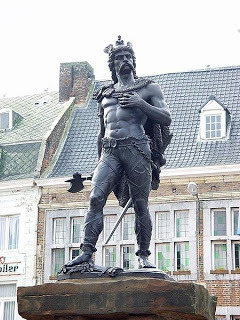 On two trips to Belgium at the beginning of this century, I saw several of the beguinages in Flanders, especially in Leuven, Bruges, and Tongeron, and the accompanying "Beguinage Churches", where the Beguines attended Mass. In Bruges I remember the tour guide's flippant remark that there just weren't enough men to go around, so the young women starting living together. I particularly enjoyed a visit to Tongeren, the home of my hostesses' grandmother, with its great beguinage and St. Catherine's Church. For me, Tongeren was doubly fascinating not only because of the beguinage, St. Catherine's and the beautiful Gothic basilica of Our Lady, but also because of its Gallo-Roman museum and its great hero Ambiorix, who rebelled against the Romans and Julius Caesar. Unfortunately, at that time during my travels, I was not a very good photographer, as my husband often complained. (And at the time, we did not have digital cameras!) Not much to share, I'm afraid. (photo source: Wikipedia commons.) More on Tongeren here.
On two trips to Belgium at the beginning of this century, I saw several of the beguinages in Flanders, especially in Leuven, Bruges, and Tongeron, and the accompanying "Beguinage Churches", where the Beguines attended Mass. In Bruges I remember the tour guide's flippant remark that there just weren't enough men to go around, so the young women starting living together. I particularly enjoyed a visit to Tongeren, the home of my hostesses' grandmother, with its great beguinage and St. Catherine's Church. For me, Tongeren was doubly fascinating not only because of the beguinage, St. Catherine's and the beautiful Gothic basilica of Our Lady, but also because of its Gallo-Roman museum and its great hero Ambiorix, who rebelled against the Romans and Julius Caesar. Unfortunately, at that time during my travels, I was not a very good photographer, as my husband often complained. (And at the time, we did not have digital cameras!) Not much to share, I'm afraid. (photo source: Wikipedia commons.) More on Tongeren here.
Returning from our first trip to Belgium, I did some research and reading into the history and spirituality of the beguine movement and found this book: Brides in the Desert: The Spirituality of the Beguines by Saskia Murk-Jansen. She focuses on the mysticism of Hadewijch of Brabant, Mechtild of Magdeburg, Marguerite Porete, and Beatrijs of Nazareth. I also dipped into Bernard McGinn's Meister Eckhart and the Beguine Mystics: Hadewijch of Brabant, Mechthild of Magdeburg, and Marguerite Porete. I think now the standard work is by Walter Simons, published by the University of Pennsylvania Press: Cities of Ladies: Beguine Communities in the Medieval Low Countries, 1200-1565, part of The Middle Ages Series:
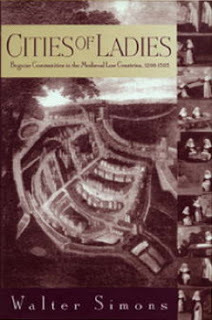 In the early thirteenth century, semireligious communities of women began to form in the cities and towns of the Low Countries. These beguines, as the women came to be known, led lives of contemplation and prayer and earned their livings as laborers or teachers.
In the early thirteenth century, semireligious communities of women began to form in the cities and towns of the Low Countries. These beguines, as the women came to be known, led lives of contemplation and prayer and earned their livings as laborers or teachers.
In Cities of Ladies, the first history of the beguines to appear in English in fifty years, Walter Simons traces the transformation of informal clusters of single women to large beguinages. These veritable single-sex cities offered lower- and middle-class women an alternative to both marriage and convent life. While the region's expanding urban economies initially valued the communities for their cheap labor supply, severe economic crises by the fourteenth century restricted women's opportunities for work. Church authorities had also grown less tolerant of religious experimentation, hailing as subversive some aspects of beguine mysticism. To Simons, however, such accusations of heresy against the beguines were largely generated from a profound anxiety about their intellectual ambitions and their claims to a chaste life outside the cloister. Under ecclesiastical and economic pressure, beguine communities dwindled in size and influence, surviving only by adopting a posture of restraint and submission to church authorities.
Walter Simons is Associate Professor of History at Dartmouth College.
I wonder if I will ever have the opportunity to return to Belgium, to Brussels and Bruges, Antwerp and Leuven, Mechelen and Tongeren--and visit Ghent for the first time to see the "Mystic Lamb"--this time with a digital camera and taking lots of pictures!
In the late 12th century a Flemish priest named Lambert le Begue established a community in Liège for the widows of crusaders who had not returned from the Holy Land. Without a protector, such women often felt obliged to seek security by joining a religious order, but many of them did not wish to devote their lives exclusively to religion. Called Beguines, the women lived in walled districts called beguinages.
Beguines took no religious vows. They could leave and marry, if they chose. They could own property and took no alms. Women of all classes were welcomed, and wealthy Beguines often brought their servants with them. They carried on professions, often in the textile industry; they did good works, such as teaching or caring for the sick. They elected women — Grandes Dames — to lead their communities. Each Beguine was expected to support herself and make a contribution to the beguinage, through work or rent payments. They had no motherhouse, no common rule, no general of the order. Every community was run according to its own rules.
Such institutions flourished in northern Europe in the High Middle Ages, particularly in the Low Countries, in northern France and the Rhineland, although they never took off in England, Norwich being the only city where there is evidence of such informal female communities. . . .
Marcella Pattyn was born in the Belgian Congo on August 18 1920 and, as a child, dreamed of entering a missionary religious order. But as she was almost blind she was rejected by several communities. It was only when a rich aunt intervened with a donation that she was accepted into the beguinage of St Amandsberg in Ghent in 1941.
There, and at the beguinage of St Elizabeth at Courtrai, where she moved in 1960, she spent her days praying, knitting clothes, weaving and making Beguine dolls, which she sold to tourists. She played the organ in the chapel and gave comfort to the sick by entertaining them on the banjo or accordion. In her later years she became a familiar figure in the streets of Courtrai, whizzing around in a motorised wheelchair.
In 1960 she was one of a community of nine. By 2008, when she moved into a nursing home, she had become, officially, the only surviving Beguine in the world.
 On two trips to Belgium at the beginning of this century, I saw several of the beguinages in Flanders, especially in Leuven, Bruges, and Tongeron, and the accompanying "Beguinage Churches", where the Beguines attended Mass. In Bruges I remember the tour guide's flippant remark that there just weren't enough men to go around, so the young women starting living together. I particularly enjoyed a visit to Tongeren, the home of my hostesses' grandmother, with its great beguinage and St. Catherine's Church. For me, Tongeren was doubly fascinating not only because of the beguinage, St. Catherine's and the beautiful Gothic basilica of Our Lady, but also because of its Gallo-Roman museum and its great hero Ambiorix, who rebelled against the Romans and Julius Caesar. Unfortunately, at that time during my travels, I was not a very good photographer, as my husband often complained. (And at the time, we did not have digital cameras!) Not much to share, I'm afraid. (photo source: Wikipedia commons.) More on Tongeren here.
On two trips to Belgium at the beginning of this century, I saw several of the beguinages in Flanders, especially in Leuven, Bruges, and Tongeron, and the accompanying "Beguinage Churches", where the Beguines attended Mass. In Bruges I remember the tour guide's flippant remark that there just weren't enough men to go around, so the young women starting living together. I particularly enjoyed a visit to Tongeren, the home of my hostesses' grandmother, with its great beguinage and St. Catherine's Church. For me, Tongeren was doubly fascinating not only because of the beguinage, St. Catherine's and the beautiful Gothic basilica of Our Lady, but also because of its Gallo-Roman museum and its great hero Ambiorix, who rebelled against the Romans and Julius Caesar. Unfortunately, at that time during my travels, I was not a very good photographer, as my husband often complained. (And at the time, we did not have digital cameras!) Not much to share, I'm afraid. (photo source: Wikipedia commons.) More on Tongeren here.Returning from our first trip to Belgium, I did some research and reading into the history and spirituality of the beguine movement and found this book: Brides in the Desert: The Spirituality of the Beguines by Saskia Murk-Jansen. She focuses on the mysticism of Hadewijch of Brabant, Mechtild of Magdeburg, Marguerite Porete, and Beatrijs of Nazareth. I also dipped into Bernard McGinn's Meister Eckhart and the Beguine Mystics: Hadewijch of Brabant, Mechthild of Magdeburg, and Marguerite Porete. I think now the standard work is by Walter Simons, published by the University of Pennsylvania Press: Cities of Ladies: Beguine Communities in the Medieval Low Countries, 1200-1565, part of The Middle Ages Series:
 In the early thirteenth century, semireligious communities of women began to form in the cities and towns of the Low Countries. These beguines, as the women came to be known, led lives of contemplation and prayer and earned their livings as laborers or teachers.
In the early thirteenth century, semireligious communities of women began to form in the cities and towns of the Low Countries. These beguines, as the women came to be known, led lives of contemplation and prayer and earned their livings as laborers or teachers.In Cities of Ladies, the first history of the beguines to appear in English in fifty years, Walter Simons traces the transformation of informal clusters of single women to large beguinages. These veritable single-sex cities offered lower- and middle-class women an alternative to both marriage and convent life. While the region's expanding urban economies initially valued the communities for their cheap labor supply, severe economic crises by the fourteenth century restricted women's opportunities for work. Church authorities had also grown less tolerant of religious experimentation, hailing as subversive some aspects of beguine mysticism. To Simons, however, such accusations of heresy against the beguines were largely generated from a profound anxiety about their intellectual ambitions and their claims to a chaste life outside the cloister. Under ecclesiastical and economic pressure, beguine communities dwindled in size and influence, surviving only by adopting a posture of restraint and submission to church authorities.
Walter Simons is Associate Professor of History at Dartmouth College.
I wonder if I will ever have the opportunity to return to Belgium, to Brussels and Bruges, Antwerp and Leuven, Mechelen and Tongeren--and visit Ghent for the first time to see the "Mystic Lamb"--this time with a digital camera and taking lots of pictures!
Published on May 31, 2013 22:30
May 30, 2013
The Dialogues of the Carmelites at the Met Opera
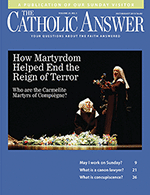
I mentioned yesterday that The Catholic Answer Magazine's cover illustration for my article on the Carmelites of Compiegne was a scene from Poulenc's opera The Dialogues of the Carmelites. The opera was recently revived at the Metropolitan Opera in NYC for three performances, in the John Dexter staging that dates from 1977 (the year I graduated from high school!).
The Wall Street Journal ran this Associated Press review:
One of the most harrowing final scenes in all of opera is the ending of Poulenc's "Dialogues of the Carmelites," when the nuns condemned by the French Revolution walk one by one to the scaffold, singing a gradually thinning chorus punctuated by the slashing sounds of a guillotine.
So emotionally drained was the audience at Saturday afternoon's performance at the Metropolitan Opera that silence lingered in the house for several moments after the curtain fell. Only then did tumultuous applause erupt for the terrific performance that had just taken place. . . .
Dexter's staging looks barely touched by time and remains a marvel of simplicity, starting with the opening image of 13 nuns lying prostrate with arms outstretched on a raised wooden platform shaped like a cross. It reportedly cost less than $100,000 at the time — mere pocket change compared with many lavish and less effective productions that have come and gone from the Met stage since.
And Terry Teachout commented further on the Dexter staging in another article:
The Metropolitan Operarecently presented a three-performance run of "Dialogues of the Carmelites," Francis Poulenc's 1957 opera about a group of nuns who were guillotined in the French Revolution. It was a revival of John Dexter's 1977 production, not a new staging, but I didn't hear anyone complaining. Mr. Dexter's "Dialogues" is universally regarded by connoisseurs as one of the Met's greatest theatrical achievements. It's also, so far as I know, the only stage production by Mr. Dexter, who died in 1990, that continues to be performed. Since he was a much-admired director who was responsible, among other things, for the original Broadway productions of "Equus" and "M. Butterfly," that makes "Dialogues" important by definition.
In a way, "Dialogues" is a kind of operatic time capsule. Long an international byword for artistic conservatism, the Met was notoriously slow to embrace contemporary stagecraft. Not so the modern-minded Mr. Dexter, who had become the company's director of productions in 1974 and was endeavoring to update its creaky style. The stark, monumental-looking set for "Dialogues," which was designed by David Reppa, was a slap in the face to old-fashioned operagoers who preferred big, fancy sets with imitation trees. Today it looks classic, in much the same way that such masterpieces of midcentury modernism as, say, Mies van der Rohe's Seagram Building or Frank Lloyd Wright's Guggenheim long ago ceased to look "modern," at least in the informal sense that most people have in mind when they use the word. They aren't shocking anymore—they're just beautiful.
The Metropolitan Opera provides a program .pdf with a synopsis, analysis and performance history, including notes about its fascinating creative provenance with a libretto by the composer, based on a screen play by Georges Bernanos, based a on a novella by Gertrude von le Fort. More on the opera here.
Published on May 30, 2013 22:30
May 29, 2013
Preview of July/August "The Catholic Answer Magazine"

There's my story about the Blessed Carmelite Martyrs of Compiegne on the cover of the July/August issue--illustrated with a scene from Poulenc's Dialogues of the Carmelites!
Watch this space for more information!
Just a little sample from the beginning of the article:
A visitor in Paris today might arrive at the Place de la Nation, a hub of transportation and commerce on the right bank of the Seine River and never know about the Revolutionary deeds of blood committed there.
Restaurants, taxis and buses ring around the Place de la Nation and its statue depicting Marianne, the symbol of the Republic, while locals walk their dogs in the park. But here, in the last hot summer of the French Revolution’s Reign of Terror, on July 17, 1794, fourteen nuns, three lay sisters and two servants of the Carmelite house of Compiègne died for their Catholic Faith.
What brought them to such a bloody end beneath the blade of the guillotine the day after the Feast of Our Lady of Mount Carmel? The answer might be surprising if we presume the ideals of liberty, fraternity and equality truly summarize the spirit of the French Revolution. After the fall of the traditional, absolute monarchy and the rise of the National Assembly with a constitutional monarchy in 1789, the state attacked the Catholic Church, confiscating churches and closing convents. . . .
That introduction is based upon my pilgrimage to the site of the Carmelites' execution and to their place of burial at Cimitiere de Picpus (in November of 2010).
Published on May 29, 2013 22:30
A Revolutionary Recital in Salzburg, 1986
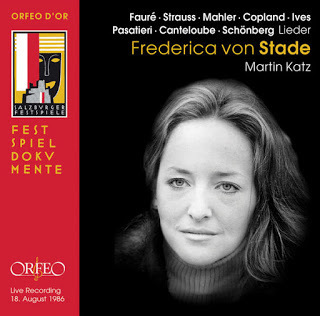 Something completely off topic:
Something completely off topic:As David Shengold in Opera News reviews this new release of an old recital notes, it seems strange, even to me after years of listening to recitals by Frederica von Stade (and even attending a few) that this program of French chansons, Strauss and Mahler, and some American composers was unusual in Salzburg during the 1986 season:
Frederica von Stade's protean approach to music has opened doors (and set standards) for Susanne Mentzer, Susan Graham, Joyce DiDonato and other lyric mezzos who have followed. On August 18, 1986, after more than a dozen years of stardom — largely in Mozart and Rossini, but with triumphs to her name in Monteverdi, Berlioz, Massenet and Richard Strauss in Europe and North America — she gave a solo recital at Salzburg's prestigious if acoustically demanding Grosses Festspielhaus. Orfeo now releases the happy results in its welcome series of live Salzburg Liederabenden.
Von Stade collaborated with longtime accompanist Martin Katz on a program whose diversity apparently raised eyebrows among the more tradition-bound Festival patrons. Yet the applause is generous. From our perspective today, the program doesn't seem all that revolutionary — Lieder eines Fahrenden Gesellen, groups of Fauré and Strauss, American songs by Copland, Ives and Pasatieri, three Brettl-Lieder, plus a quartet of sunny Canteloube songs, quite delightfully done, and encores by Poulenc and Offenbach. But a quarter-century ago, many recital audiences largely expected Schubert, Schumann and Brahms. Von Stade is in very good estate here, demonstrating a fine balance between the strengths of her youthful and mature vocal personae. Katz is an alert and supportive partner, his sound steady if sometimes a mite foursquare.
Von Stade kept many of these songs in her recital repertoire for years--we heard her Strauss, Faure, Canteloube, and more Poulenc at Johnson County Community College in Kansas City, Kansas years ago.
Composers/Works: (No texts or translations)
G. Fauré: Les roses d'Ispahan
G. Fauré: Mandoline
G. Fauré: Au cimetière
G. Fauré: La Rose
R. Strauss: Rote Rosen
R. Strauss: Die erwachte Rose
R. Strauss: Begegnung
G. Mahler: Wenn mein Schatz Hochzeit macht (aus: Lieder eines fahrenden Gesellen)
G. Mahler: Ging heut' morgen übers Feld (aus: Lieder eines fahrenden Gesellen)
G. Mahler: Ich hab' ein glühend Messer (aus: Lieder eines fahrenden Gesellen)
G. Mahler: Die zwei blauen Augen (aus: Lieder eines fahrenden Gesellen)
A. Copland: Why do they shut me out of Heaven?
Ch. Ives: Serenity (A unison chant, 1919)
Ch. Ives: Memories (Very Pleasant, Rather Sad)
Th. Pasatieri: Vocal Modesty
M.-J. Canteloube: Auprès de ma blonde (Ronde d'Ile de France)
M.-J. Canteloube: Où irai-je me plaindre? (Chant de Haut-Dauphiné)
M.-J. Canteloube: Au près de la Rose (Ronde d'Albret et Gascogne)
M.-J. Canteloube: D'où venez-vous, fillette? (Chant de Provence)
A. Schönberg: Galathea (aus: Brettl-Lieder)
A. Schönberg: Gigerlette (aus: Brettl-Lieder)
A. Schönberg: Arie aus dem Spiegel von Arkadien (aus: Brettl-Lieder)
F. Poulenc: Fêtes galantes
J. Offenbach: Ah! quel dîner je viens de faire (Schwipslied - aus: La Perichole)
One of my favorites in the collection is Faure's Mandoline set to verse by Verlaine:
Les donneurs de sérénades
Et les belles écouteuses
Échangent des propos fades
Sous les ramures chanteuses.
C'est Tircis et c'est Aminte,
Et c'est l'éternel Clitandre,
Et c'est Damis qui pour mainte
Cruelle maint [fait] vers tendre.
Leurs courtes vestes de soie,
Leurs longues robes à queues,
Leur élégance, leur joie
Et leurs molles ombres bleues,
Tourbillonent dans l'extase
D'une lune rose et grise,
Et la mandoline jase
Parmi les frissons de brise.
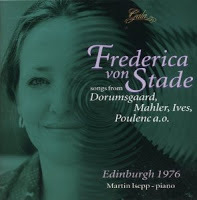 If you want to hear Frederica von Stade's voice ten years earlier in a live recital, there is a CD of one in Edinburgh with Martin Isepp as accompanist. Mahler, Ives, Poulenc, and Offenbach are on the program there too:
If you want to hear Frederica von Stade's voice ten years earlier in a live recital, there is a CD of one in Edinburgh with Martin Isepp as accompanist. Mahler, Ives, Poulenc, and Offenbach are on the program there too:--Cachez beaux yeux ; L'amour de moy ; Le célèbre menuet / Arne Dorumsgaard
--Lieder eines fahrenden Gesellen: Wenn mein Schatz Hochzeit macht ; Ging heut' morgens übers Feld ; Ich hab' ein glühend Messer ; Die zwei blauen Augen / Gustav Mahler
--Ann Street ; Two little flowers ; The side show ; Memories ; Tom sails away / Charles E. Ives
--A sa guitare ; Chansons villageoises: Les gars qui vont à la fête ; Banalités: Hôtel ; Le portrait ; Deux poèmes: Fêtes galantes / Francis Poulenc
--Folksong arrangements: O Waly, Waly ; Come you not from Newcastle; Oliver Cromwell / Benjamin Britten
--La perichole: Ah, quel diner! / Jacques Offenbach
--Jenny Rebecca / Carol Hall
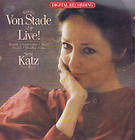 Many of von Stade's CBS Masterworks LPs have been reissued on CD by Archiv Music, including her first CBS Song Recital, but they have not released her Live! Recital with arie antiche by Vivaldi, Durante, Scarlatti, Marcello, and Rossini--plus a repeat of the Copland song on this new disc, Virgil Thomson's "Prayer to St. Catherine" and two songs composed by Richard Hundley. Her performance of "Come Ready to See Me" by Richard Hundley is wonderfully evocative.
Many of von Stade's CBS Masterworks LPs have been reissued on CD by Archiv Music, including her first CBS Song Recital, but they have not released her Live! Recital with arie antiche by Vivaldi, Durante, Scarlatti, Marcello, and Rossini--plus a repeat of the Copland song on this new disc, Virgil Thomson's "Prayer to St. Catherine" and two songs composed by Richard Hundley. Her performance of "Come Ready to See Me" by Richard Hundley is wonderfully evocative.I agree with her boilerplate bio's comments about her recitals:
A respected recitalist, Miss von Stade combines her expressive vocalism and keen musicianship with a gift for communication engaging audiences throughout the world. Here too, her repertoire encompasses an expansive range, from the Italian "Arie antiche" to the songs of contemporary composers such as Dominick Argento, who compose specifically for her, from the classical style of Mozart and Haydn to the music of Broadway's greatest songs.
I hope that Archiv Music do release the Live! disc simply because it has some unique repertoire! (And while they're at it, her recording of Raymond Leppard's version of Claudio Monteverdi's Il Ritorno d'Ulisse in Patria with Richard Stilwell cries out for re-release, too).
Published on May 29, 2013 22:30
May 28, 2013
Symbol of Religious Liberty Rebuilt in Maryland
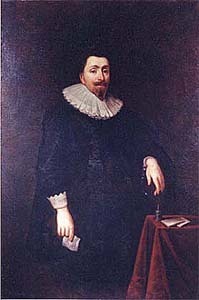 The National Catholic Register has this story about the rebuilding of a Catholic chapel in historic St. Mary's City, Maryland:
The National Catholic Register has this story about the rebuilding of a Catholic chapel in historic St. Mary's City, Maryland:When and where did religious freedom begin in what is now the United States? The answer is 1634, and the place is St. Mary’s City, Maryland. Founded by Catholic proprietor Cecil Calvert, Lord Baltimore, Maryland offered — from the start — liberty of conscience and the free exercise of religion to all. The colony offered a new concept: no established religion funded by the government. One of the most powerful symbols of this policy was expressed in the construction of the first major Catholic church in English America during the 1660s. Preceded by two earlier wooden chapels built by Jesuit Father Andrew White, who is often called the "Apostle of Maryland," the brick chapel was the first brick structure in the colony. At the time, no freestanding Catholic church could be built anywhere else in the English-speaking world. The Catholic, Quaker and Presbyterian faiths, and many others, took root and flourished in early Maryland. However, following a rebellion in 1689 against Lord Baltimore and the imposition of the royal government, Maryland’s revolutionary policy of religious freedom ended. Read the rest here. Here's more information about St. Mary's City and its exhibits--please note that the rebuilt chapel is, as Dr. Miller's article in the National Catholic Register notes, an exhibit (not a site of worship): The chapel is a museum exhibit of Historic St. Mary’s City, but it is also a place for visitors to learn about and contemplate this deep history and pray in a sacred and peaceful setting surrounded by the mortal remains of hundreds of Catholics who first planted the seeds of faith and religious liberty on these shores. The chapel at St. Mary’s is a powerful symbol of the religious freedom and respect for conscience that Lord Baltimore and other Catholics introduced to these shores for the first time in 1634. It is a key place to explore the beginning of these fundamental human rights and the Church in America.
Published on May 28, 2013 23:00
Nancy Bilyeau on Anne of Cleves, the Real Survivor
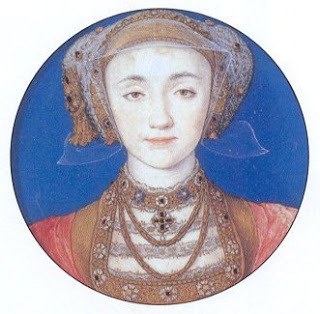 Author of The Crown and The Chalice, Nancy Bilyeau presents seven surprising facts about Henry VIII's fourth wife, Anne of Cleves, including this one:
Author of The Crown and The Chalice, Nancy Bilyeau presents seven surprising facts about Henry VIII's fourth wife, Anne of Cleves, including this one:Hans Holbein painted her accurately. The question of Anne’s appearance continues to baffle modern minds. In portraits she looks attractive, certainly prettier than Jane Seymour. A French ambassador who saw her in Cleves said she was “of middling beauty and of very assured and resolute countenance.”
It is still unclear how hard Thomas Cromwell pushed for this marriage, but certainly he was not stupid enough to trick his volatile king into wedding someone hideous. The famous Hans Holbein was told to paint truthful portraits of Anne and her sister Amelia. After looking at them, Henry VIII chose Anne. Later the king blamed people for overpraising her beauty but he did not blame or punish Holbein. The portrait captures her true appearance. While we don't find her repulsive, Henry did.
And even though Thomas Cromwell had arranged this marriage with the Duchy of Cleves for a diplomatic alliance with one of the Protestant powers on the Continent:
Anne was born a Catholic and died a Catholic. Her mother, Princess Maria of Julich-Berg, had traditional religious values and brought up her daughters as Catholics, no matter what Martin Luther said. Their brother, Duke William, was an avowed Protestant, and the family seems to have moved in that direction when he succeeded to his father’s title.
Anne was accommodating when it came to religion. She did not hesitate to follow the lead of her husband Henry VIII, who was head of the Church of England. But in 1553, when her step-daughter Mary took the throne, she asked that Anne become a Catholic. Anne agreed. When she was dying, she requested that she have “the suffrages of the holy church according to the Catholic faith.”
Read the rest here.
Published on May 28, 2013 22:30
May 27, 2013
Also from Cambridge University Press: A New Book on the Counter-Reformation
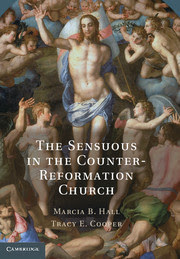
While searching for Andy Wood's forthcoming book, The Memory of the People on the Cambridge University Press website, I found this intriguing study, The Sensuous in the Counter-Reformation Church (Cambridge University Press; Not yet published - available from July 2013), edited by: Marcia B. Hall and Tracy E. Cooper, both of Temple University, Philadelphia:
This book examines the promotion of the sensuous as part of religious experience in the Roman Catholic Church of the early modern period. During the Counter-Reformation, every aspect of religious and devotional practice was reviewed, including the role of art and architecture, and the invocation of the five senses to incite devotion became a hotly contested topic. The Protestants condemned the material cult of veneration of relics and images, rejecting the importance of emotion and the senses and instead promoting the power of reason in receiving the Word of God. After much debate, the Church concluded that the senses are necessary to appreciate the sublime, and that they derive from the Holy Spirit. As part of its attempt to win back the faithful, the Church embraced the sensuous and promoted the use of images, relics, liturgy, processions, music, and theater as important parts of religious experience.
Table of Contents:
1. Introduction; Marcia B. Hall
2. The sensuous: recent research; Tracy E. Cooper
3. Trent, sacred images, and Catholics' senses of the sensuous; John W. O'Malley
4. The world made flesh: spiritual subjects and carnal depictions in Renaissance art; Bette Talvacchia
5. How words control images: the rhetoric of decorum in Counter-Reformation Italy; Robert Gaston
6. Custodia degli occhi: discipline and desire in post-Tridentine Italian art; Maria Loh
7. Raffaelle Borghini and the corpus of Florentine art in an age of reform; Stuart Lingo
8. Censure and censorship in Rome ca.1600: visitation of Clement VIII and the visual arts; Opher Mansour
9. Painting virtuously: the Counter-Reform and the reform of artists' education in Rome between guild and academy; Peter Lukehart
10. Carlo Borromeo and the dangers of lay women in church; Richard Scofield
11. 'To be in heaven': Saint Filippo Neri between aesthetic emotion and mystical ecstasy; Costanza Barbieri
12. Rebuilding faith through art: Christoph Schwarz's altarpiece for the new Jesuit school in Munich Jeffrey Chipps Smith
13. 'Until shadows disperse': Augustine's twilight; Meredith Gill
14. A machine for souls: allegory before and after Trent; Amy Powell.
Some of the titles of the essays reminded me of Sir Kenneth Clark's assessment of Catholic Counter-Reformation efforts, especially in art and architecture, as they asserted Catholic teaching and thought about the Blessed Virgin Mary, the saints, the Sacraments, and other controversies--"the Church gave imaginative expression to deep-seated human impulses. And it had another great strength which one may say was part of Mediterranean civilisation--or at any rate a legacy from the pagan Renaissance: it was not afraid of the human body. . . . [Speaking of Titian, Rubens, and Bernini] In their work the conflict between flesh and spirit is gloriously resolved." (pages 178 to 182, Chapter 7, Grandeur and Obedience, Civilisation: A Personal View).
Clark uses Peter Paul Ruben's painting, "Sinners Saved by Penitence", as an example--and this site features the illustrated script of the episode--noting, "And in Rubens's picture of that extremely un-Protestant subject "Sinners saved by Penitence", he has achieved in the repentant Magdalene, and even in the figure of Christ himself, a noble sensuality, perfectly at one with an unquestioning faith." (page 182). Father John O'Malley's essay and Bette Talvacchia's particularly seem to address Clark's analysis.
Because of my interest in the Counter-Reformation, I might have to queue this book up on my wish list!
Published on May 27, 2013 22:30
May 26, 2013
Also At the Bodleian: J.R.R. Tolkien and C.S. Lewis in the Summer Exhibit
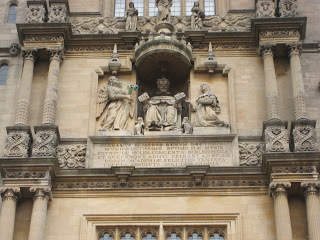
In addition to the Gerard Manley Hopkins' manuscript new, J.R.R. Tolkien and C.S. Lewis are featured in a Bodleian exhibit on "Magical Books: from the Middle Ages to Middle-earth":
The Bodleian’s summer exhibition, Magical Books: from the Middle Ages to Middle-earth, opens to the public on Thursday, 23 May and will feature the work of five celebrated authors of children’s fantasy literature: C.S. LEWIS, J.R.R. TOLKIEN, SUSAN COOPER, ALAN GARNER and PHILIP PULLMAN.
From Bodleian’s unique holdings of these authors’ papers, the Magical Books exhibition will include a selection of Tolkien’s original artwork for The Hobbit and The Lord of the Rings; C.S. Lewis’s ‘Lefay notebook’ and his map of Narnia, and manuscripts of novels and poems by Alan Garner, Philip Pullman and Susan Cooper, many of which will be exhibited here for the first time.
On public display for the first time will be the manuscript of ‘The Fall of Arthur’, a previously unknown work by Tolkien. The poem was one of several projects left uncompleted at the time of the author’s death. It is published for the first time on 23 May 2013, the day the exhibition opens to the public.
The exhibition also celebrates the authors’ links with Oxford and with the historic Bodleian Library in particular. All five authors were Oxford-educated and are considered members of the group of writers informally known as the ‘Oxford School’.
Susan Cooper is known for her The Dark Rising sequence of books; Alan Garner for children's books that retell traditional British folk tales; Philip Pullman for the controversial His Dark Materials trilogy.
There is a book about the exhibition and a series of lectures.
Note: picture taken by Stephanie A. Mann
Published on May 26, 2013 22:30
St. Augustine of Canterbury
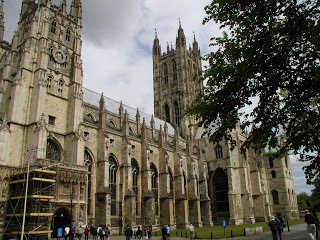
In honor of St. Augustine of Canterbury today. My husband and I visited the Cathedral in Canterbury several years ago. Here are some pics from that visit.
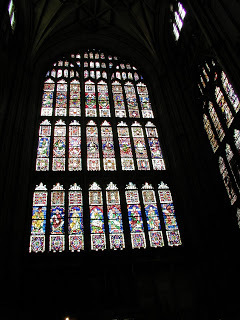
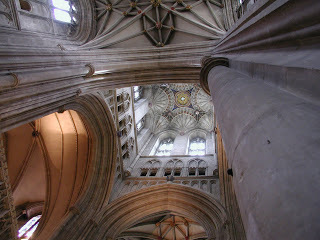
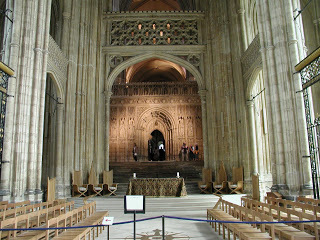
Also, here's a link to an interesting site on sacred (Anglican) destinations in England. St. Augustine's in Ramsgate, designed and built by Augustus Pugin, is Catholic England's national shrine. More about it here and some pictures of the very recent Ordinariate pilgrimage to Ramsgate.
Published on May 26, 2013 22:30
May 25, 2013
Notre Dame de Paris Desecrated (Twice) in May, 2013
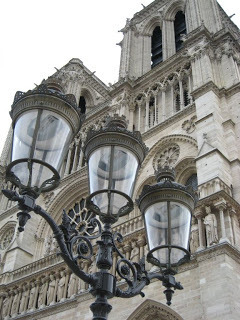
I was so stunned and sad to hear about the two demonstrations and desecrations of Notre Dame de Paris--a Cathedral I have visited, photographed, attended Mass in, prayed in, and been so impressed with for so many years. I remember the first time I crossed Pont au Double from the Left Bank, saw the towers and flying buttresses and wept for joy.
To hear that a man killed himself near the Altar and then that a half-naked woman pretended to commit suicide [WARNING: story includes photograph] to mock him the next day made me weep for sorrow.
Cathedrale Notre Dame de Paris is a tourist site, I know, but it is also an active sanctuary of worship, with Mass celebrated many times a day, the Sacrament of Confession offered to penitents (and an opportunity for counseling for non-Catholics), and the Chapel of the Blessed Sacrament behind the choir (with a sign proclaiming it is only for prayer)--Notre Dame de Paris is NOT the place for political protests. My husband and I have attended Sunday Mass there several times, at least twice on Trinity Sunday, thrilling at the history, enjoying the beatiful Gregorian chant (we usually attended Lauds and the Gregorian Mass), and wondering at the patience of the ushers, who had to shoo the tourists from the nave during Mass!
As Canon Lawyer Ed Peters on his blog, In the Light of the Law, reminds us:
Suicide—whatever mental/emotional problems induce some to commit it and which might even mitigate its culpability—is objectively a gravely evil action (CCC 2280-2283) and may never be licitly chosen. When committed in a sacred place such as a church or shrine, suicide effects the “violation” of that space and divine worship (as opposed to personal prayers) may not be offered there until the place is rehabilitated in accord with canon and liturgical law (1983 CIC 1211, olim 1917 CIC 1172; see also 1983 CIC 1376).
When Dominique Venner killed himself with a shotgun blast to the head inside Paris’ Notre Dame Cathedral (indeed, it seems, within the sanctuary itself) he desecrated that great church. If it turns out that Venner killed himself in protest over France’s new “gay marriage” law, then, besides condemning the classical scandal his deed produced, one may further observe that all he really accomplished was to make opponents of “gay marriage” look like kooks, and to deprive, for a time, the faithful of France of a particularly powerful place of worship from which to ask God’s help in preserving the natural and holy institution of marriage in their nation.
Only the Evil One would take pleasure in that.
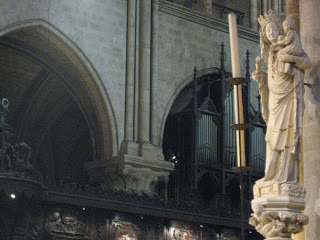 Our Lady, pray for us!
Our Lady, pray for us!In reparation for these horrors of the week after Pentecost, here are some words by Blessed John Henry Newman on the Solemnity of the Holy Trinity:
On this day, then, we should forget ourselves, and fix our thoughts upon God. Yet men are not willing to forget themselves; they do not like to become, as it were, nothing, and to have no work but faith. They like argument and proof better; they like to be convinced of a truth to their own satisfaction before they receive it, when, perhaps, such satisfaction is impossible. This happens in the sacred subject before us. The solemn mystery of the Trinity in Unity is contained in Scripture. We all know this; there is no doubt about it. Yet, though it be in Scripture, it does not follow that every one of us should be a fit judge whether and where it is in Scripture. It may be contained there fully, and yet we may be unable to see it fully, for various reasons. Now this is the great mistake which some persons fall into; they think, because the doctrine is maintained as being in Scripture by those who maintain it as true, that therefore they have a right to say that they will not believe it till it is proved to them from Scripture. It is nothing to them that the great multitude of good and holy men in all ages have held it. {329} They act like Thomas, who would not believe his brother Apostles that our Lord was risen, till he had as much proof as they, and who said, "Except I see and touch for myself, I will not believe." . . .
Let us, then, learn from this Festival to walk by faith; that is, not to ask jealously and coldly for strict arguments, but to follow generously what has fair evidence for it, even though it might have fuller or more systematic evidence. It is in this way that we all believe that there is a God. A subtle infidel might soon perplex any one of us. Of course he might. Our very state and warfare is one of faith. Let us aim at, let us reach after and (as it were) catch at the things of the next world. There is a voice within us, which assures us that there is something higher than earth. We cannot analyze, define, contemplate what it is that thus whispers to us. It has no shape or material form. There is that in our hearts which prompts us to religion, and which condemns and chastises sin. And {340} this yearning of our nature is met and sustained, it finds an object to rest upon, when it hears of the existence of an All-powerful, All-gracious Creator. It incites us to a noble faith in what we cannot see.
Let us exercise a similar faith, as regards the Mysteries of Revelation also. Here is the true use of Scripture in leading us to the truth. If we read it humbly and inquire teachably, we shall find; we shall have a deep impression on our minds that the doctrines of the Creed are there, though we may not be able to put our hands upon particular texts, and say how much of it is contained here and how much there. But, on the other hand, if we read in order to prove those doctrines, in a critical, argumentative way, then all traces of them will disappear from Scripture as if they were not there. They will fade away insensibly like hues at sunset, and we shall be left in darkness. We shall come to the conclusion that they are not in Scripture, and shall, perhaps, boldly call them unscriptural. Religious convictions cannot be forced; nor is Divine truth ours to summon at will. If we determine that we will find it out, we shall find nothing. Faith and humility are the only spells which conjure up the image of heavenly things into the letter of inspiration; and faith and humility consist, not in going about to prove, but in the outset confiding on the testimony of others. Thus afterwards on looking back, we shall find we have proved what we did not set out to prove. We cannot control our reasoning powers, nor exert them at our will or at any moment. It is so with other faculties of the mind also. Who can command his {341} memory? The more you try to recall what you have forgotten, the less is your chance of success. Leave thinking about it, and perhaps memory returns. And in like manner, the more you set yourself to argue and prove, in order to discover truth, the less likely you are to reason correctly and to infer profitably. You will be caught by sophisms, and think them splendid discoveries. Be sure, the highest reason is not to reason on system, or by rules of argument, but in a natural way; not with formal intent to draw out proofs, but trusting to God's blessing that you may gain a right impression from what you read. If your reasoning powers are weak, using argumentative forms will not make them stronger. They will enable you to dispute acutely and to hit objections, but not to discover truth. There is nothing creative, nothing progressive in exhibitions of argument. The utmost they do is to enable us to state well what we have already discovered by the tranquil exercise of our reason. Faith and obedience are the main things; believe and do, and pray to God for light, and you will reason well without knowing it.
Let us not then seek for signs and wonders; for clear, or strong, or compact, or original arguments; but let us believe; evidence will come after faith as its reward, better than before it as its groundwork. Faith soars aloft; it listens for the notes of heaven, the faint voices or echoes which scarcely reach the earth, and it thinks them worth all the louder sounds of cities or of schools of men. It is foolishness in the eyes of the world; but it is a foolishness of God wiser than the {342} world's wisdom. Let us embrace the sacred Mystery of the Trinity in Unity, which, as the Creed tells us, is the ground of the Catholic religion. Let us think it enough, let us think it far too great a privilege, for sinners such as we are, for a fallen people in a degenerate age, to inherit the faith once delivered to the Saints; let us accept it thankfully; let us guard it watchfully; let us transmit it faithfully to those who come after us.
Note: both pictures taken by Mark Mann.
Published on May 25, 2013 22:30



